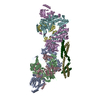+ Open data
Open data
- Basic information
Basic information
| Entry |  | |||||||||
|---|---|---|---|---|---|---|---|---|---|---|
| Title | FluPol-NS2 complex (local refinement) | |||||||||
 Map data Map data | ||||||||||
 Sample Sample |
| |||||||||
 Keywords Keywords | PROTEIN BINDING | |||||||||
| Function / homology |  Function and homology information Function and homology informationexit of virus from host cell nucleus through nuclear pore / cap snatching / viral transcription / symbiont-mediated suppression of host mRNA transcription via inhibition of RNA polymerase II activity / 7-methylguanosine mRNA capping / host cell mitochondrion / symbiont-mediated suppression of host cytoplasmic pattern recognition receptor signaling pathway via inhibition of MAVS activity / virion component / endonuclease activity / Hydrolases; Acting on ester bonds ...exit of virus from host cell nucleus through nuclear pore / cap snatching / viral transcription / symbiont-mediated suppression of host mRNA transcription via inhibition of RNA polymerase II activity / 7-methylguanosine mRNA capping / host cell mitochondrion / symbiont-mediated suppression of host cytoplasmic pattern recognition receptor signaling pathway via inhibition of MAVS activity / virion component / endonuclease activity / Hydrolases; Acting on ester bonds / host cell cytoplasm / symbiont-mediated suppression of host gene expression / viral translational frameshifting / RNA-directed RNA polymerase / viral RNA genome replication / nucleotide binding / RNA-directed RNA polymerase activity / DNA-templated transcription / host cell nucleus / RNA binding / metal ion binding Similarity search - Function | |||||||||
| Biological species |  Influenza A virus (A/Aichi/2/1968(H3N2)) / Influenza A virus (A/Aichi/2/1968(H3N2)) /  Influenza A virus (A/nt/60/1968(H3N2)) / Influenza A virus (A/nt/60/1968(H3N2)) /  Influenza A virus (strain A/Hong Kong/1/1968 H3N2) Influenza A virus (strain A/Hong Kong/1/1968 H3N2) | |||||||||
| Method | single particle reconstruction / cryo EM / Resolution: 3.0 Å | |||||||||
 Authors Authors | Peng Q / Sun JQ | |||||||||
| Funding support |  China, 2 items China, 2 items
| |||||||||
 Citation Citation |  Journal: EMBO Rep / Year: 2024 Journal: EMBO Rep / Year: 2024Title: NS2 induces an influenza A RNA polymerase hexamer and acts as a transcription to replication switch. Authors: Junqing Sun / Lu Kuai / Lei Zhang / Yufeng Xie / Yanfang Zhang / Yan Li / Qi Peng / Yuekun Shao / Qiuxian Yang / Wen-Xia Tian / Junhao Zhu / Jianxun Qi / Yi Shi / Tao Deng / George F Gao /  Abstract: Genome transcription and replication of influenza A virus (FluA), catalyzed by viral RNA polymerase (FluAPol), are delicately controlled across the virus life cycle. A switch from transcription to ...Genome transcription and replication of influenza A virus (FluA), catalyzed by viral RNA polymerase (FluAPol), are delicately controlled across the virus life cycle. A switch from transcription to replication occurring at later stage of an infection is critical for progeny virion production and viral non-structural protein NS2 has been implicated in regulating the switch. However, the underlying regulatory mechanisms and the structure of NS2 remained elusive for years. Here, we determine the cryo-EM structure of the FluAPol-NS2 complex at ~3.0 Å resolution. Surprisingly, three domain-swapped NS2 dimers arrange three symmetrical FluPol dimers into a highly ordered barrel-like hexamer. Further structural and functional analyses demonstrate that NS2 binding not only hampers the interaction between FluAPol and the Pol II CTD because of steric conflicts, but also impairs FluAPol transcriptase activity by stalling it in the replicase conformation. Moreover, this is the first visualization of the full-length NS2 structure. Our findings uncover key molecular mechanisms of the FluA transcription-replication switch and have implications for the development of antivirals. | |||||||||
| History |
|
- Structure visualization
Structure visualization
| Supplemental images |
|---|
- Downloads & links
Downloads & links
-EMDB archive
| Map data |  emd_39020.map.gz emd_39020.map.gz | 587 MB |  EMDB map data format EMDB map data format | |
|---|---|---|---|---|
| Header (meta data) |  emd-39020-v30.xml emd-39020-v30.xml emd-39020.xml emd-39020.xml | 23.5 KB 23.5 KB | Display Display |  EMDB header EMDB header |
| Images |  emd_39020.png emd_39020.png | 29.1 KB | ||
| Filedesc metadata |  emd-39020.cif.gz emd-39020.cif.gz | 7.7 KB | ||
| Others |  emd_39020_half_map_1.map.gz emd_39020_half_map_1.map.gz emd_39020_half_map_2.map.gz emd_39020_half_map_2.map.gz | 622.1 MB 622.1 MB | ||
| Archive directory |  http://ftp.pdbj.org/pub/emdb/structures/EMD-39020 http://ftp.pdbj.org/pub/emdb/structures/EMD-39020 ftp://ftp.pdbj.org/pub/emdb/structures/EMD-39020 ftp://ftp.pdbj.org/pub/emdb/structures/EMD-39020 | HTTPS FTP |
-Validation report
| Summary document |  emd_39020_validation.pdf.gz emd_39020_validation.pdf.gz | 832.3 KB | Display |  EMDB validaton report EMDB validaton report |
|---|---|---|---|---|
| Full document |  emd_39020_full_validation.pdf.gz emd_39020_full_validation.pdf.gz | 831.8 KB | Display | |
| Data in XML |  emd_39020_validation.xml.gz emd_39020_validation.xml.gz | 19.4 KB | Display | |
| Data in CIF |  emd_39020_validation.cif.gz emd_39020_validation.cif.gz | 23 KB | Display | |
| Arichive directory |  https://ftp.pdbj.org/pub/emdb/validation_reports/EMD-39020 https://ftp.pdbj.org/pub/emdb/validation_reports/EMD-39020 ftp://ftp.pdbj.org/pub/emdb/validation_reports/EMD-39020 ftp://ftp.pdbj.org/pub/emdb/validation_reports/EMD-39020 | HTTPS FTP |
-Related structure data
| Related structure data |  8y7mMC  8y7oC M: atomic model generated by this map C: citing same article ( |
|---|---|
| Similar structure data | Similarity search - Function & homology  F&H Search F&H Search |
- Links
Links
| EMDB pages |  EMDB (EBI/PDBe) / EMDB (EBI/PDBe) /  EMDataResource EMDataResource |
|---|
- Map
Map
| File |  Download / File: emd_39020.map.gz / Format: CCP4 / Size: 669.9 MB / Type: IMAGE STORED AS FLOATING POINT NUMBER (4 BYTES) Download / File: emd_39020.map.gz / Format: CCP4 / Size: 669.9 MB / Type: IMAGE STORED AS FLOATING POINT NUMBER (4 BYTES) | ||||||||||||||||||||||||||||||||||||
|---|---|---|---|---|---|---|---|---|---|---|---|---|---|---|---|---|---|---|---|---|---|---|---|---|---|---|---|---|---|---|---|---|---|---|---|---|---|
| Projections & slices | Image control
Images are generated by Spider. | ||||||||||||||||||||||||||||||||||||
| Voxel size | X=Y=Z: 0.89 Å | ||||||||||||||||||||||||||||||||||||
| Density |
| ||||||||||||||||||||||||||||||||||||
| Symmetry | Space group: 1 | ||||||||||||||||||||||||||||||||||||
| Details | EMDB XML:
|
-Supplemental data
-Half map: #2
| File | emd_39020_half_map_1.map | ||||||||||||
|---|---|---|---|---|---|---|---|---|---|---|---|---|---|
| Projections & Slices |
| ||||||||||||
| Density Histograms |
-Half map: #1
| File | emd_39020_half_map_2.map | ||||||||||||
|---|---|---|---|---|---|---|---|---|---|---|---|---|---|
| Projections & Slices |
| ||||||||||||
| Density Histograms |
- Sample components
Sample components
-Entire : FluPol-NS2 complex (local refinement)
| Entire | Name: FluPol-NS2 complex (local refinement) |
|---|---|
| Components |
|
-Supramolecule #1: FluPol-NS2 complex (local refinement)
| Supramolecule | Name: FluPol-NS2 complex (local refinement) / type: complex / ID: 1 / Parent: 0 / Macromolecule list: all |
|---|
-Supramolecule #2: FluPol
| Supramolecule | Name: FluPol / type: complex / ID: 2 / Parent: 1 / Macromolecule list: #1-#3 |
|---|---|
| Source (natural) | Organism:  Influenza A virus (A/Aichi/2/1968(H3N2)) Influenza A virus (A/Aichi/2/1968(H3N2)) |
-Supramolecule #3: NS2
| Supramolecule | Name: NS2 / type: complex / ID: 3 / Parent: 1 / Macromolecule list: #4 |
|---|---|
| Source (natural) | Organism:  Influenza A virus (A/Aichi/2/1968(H3N2)) Influenza A virus (A/Aichi/2/1968(H3N2)) |
-Macromolecule #1: Polymerase acidic protein
| Macromolecule | Name: Polymerase acidic protein / type: protein_or_peptide / ID: 1 / Number of copies: 2 / Enantiomer: LEVO / EC number: Hydrolases; Acting on ester bonds |
|---|---|
| Source (natural) | Organism:  Influenza A virus (A/nt/60/1968(H3N2)) / Strain: A/NT/60/68/(H3N2) Influenza A virus (A/nt/60/1968(H3N2)) / Strain: A/NT/60/68/(H3N2) |
| Molecular weight | Theoretical: 84.625414 KDa |
| Recombinant expression | Organism:  Homo sapiens (human) Homo sapiens (human) |
| Sequence | String: MHHHHHHHHG SGSMEDFVRQ CFNPMIVELA EKAMKEYGED LKIETNKFAA ICTHLEVCFM YSDFHFINEQ GESIVVELDD PNALLKHRF EIIEGRDRTM AWTVVNSICN TTGAEKPKFL PDLYDYKENR FIEIGVTRRE VHIYYLEKAN KIKSENTHIH I FSFTGEEM ...String: MHHHHHHHHG SGSMEDFVRQ CFNPMIVELA EKAMKEYGED LKIETNKFAA ICTHLEVCFM YSDFHFINEQ GESIVVELDD PNALLKHRF EIIEGRDRTM AWTVVNSICN TTGAEKPKFL PDLYDYKENR FIEIGVTRRE VHIYYLEKAN KIKSENTHIH I FSFTGEEM ATKADYTLDE ESRARIKTRL FTIRQEMANR GLWDSFRQSE RGEETIEERF EITGTMRRLA DQSLPPNFSC LE NFRAYVD GFEPNGYIEG KLSQMSKEVN AKIEPFLKTT PRPIRLPDGP PCFQRSKFLL MDALKLSIED PSHEGEGIPL YDA IKCMRT FFGWKEPYIV KPHEKGINPN YLLSWKQVLA ELQDIENEEK IPRTKNMKKT SQLKWALGEN MAPEKVDFDN CRDV SDLKQ YDSDEPELRS LSSWIQNEFN KACELTDSTW IELDEIGEDV APIEYIASMR RNYFTAEVSH CRATEYIMKG VYINT ALLN ASCAAMDDFQ LIPMISKCRT KEGRRKTNLY GFIIKGRSHL RNDTDVVNFV SMEFSLTDPR LEPHKWEKYC VLEIGD MLL RSAIGQMSRP MFLYVRTNGT SKIKMKWGME MRRCLLQSLQ QIESMIEAES SVKEKDMTKE FFENKSETWP IGESPKG VE DGSIGKVCRT LLAKSVFNSL YASPQLEGFS AESRKLLLVV QALRDNLEPG TFDLEGLYEA IEECLINDPW VLLNASWF N SFLTHALR UniProtKB: Polymerase acidic protein |
-Macromolecule #2: RNA-directed RNA polymerase catalytic subunit
| Macromolecule | Name: RNA-directed RNA polymerase catalytic subunit / type: protein_or_peptide / ID: 2 / Number of copies: 2 / Enantiomer: LEVO / EC number: RNA-directed RNA polymerase |
|---|---|
| Source (natural) | Organism:  Influenza A virus (strain A/Hong Kong/1/1968 H3N2) Influenza A virus (strain A/Hong Kong/1/1968 H3N2)Strain: A/Hong Kong/1/1968 H3N2 |
| Molecular weight | Theoretical: 86.524086 KDa |
| Recombinant expression | Organism:  Homo sapiens (human) Homo sapiens (human) |
| Sequence | String: MDVNPTLLFL KVPAQNAIST TFPYTGDPPY SHGTGTGYTM DTVNRTHQYS EKGKWTTNTE TGAPQLNPID GPLPEDNEPS GYAQTDCVL EAMAFLEESH PGIFENSCLE TMEVVQQTRV DRLTQGRQTY DWTLNRNQPA ATALANTIEV FRSNGLTANE S GRLIDFLK ...String: MDVNPTLLFL KVPAQNAIST TFPYTGDPPY SHGTGTGYTM DTVNRTHQYS EKGKWTTNTE TGAPQLNPID GPLPEDNEPS GYAQTDCVL EAMAFLEESH PGIFENSCLE TMEVVQQTRV DRLTQGRQTY DWTLNRNQPA ATALANTIEV FRSNGLTANE S GRLIDFLK DVMESMDKEE MEITTHFQRK RRVRDNMTKK MVTQRTIGKK KQRVNKRSYL IRALTLNTMT KDAERGKLKR RA IATPGMQ IRGFVYFVET LARSICEKLE QSGLPVGGNE KKAKLANVVR KMMTNSQDTE LSFTITGDNT KWNENQNPRM FLA MITYIT KNQPEWFRNV LSIAPIMFSN KMARLGKGYM FESKSMKLRT QIPAEMLASI DLKYFNESTR KKIEKIRPLL IDGT ASLSP GMMMGMFNML STVLGVSILN LGQKRYTKTT YWWDGLQSSD DFALIVNAPN HEGIQAGVDR FYRTCKLVGI NMSKK KSYI NRTGTFEFTS FFYRYGFVAN FSMELPSFGV SGINESADMS IGVTVIKNNM INNDLGPATA QMALQLFIKD YRYTYR CHR GDTQIQTRRS FELKKLWEQT RSKAGLLVSD GGPNLYNIRN LHIPEVCLKW ELMDEDYQGR LCNPLNPFVS HKEIESV NN AVVMPAHGPA KSMEYDAVAT THSWIPKRNR SILNTSQRGI LEDEQMYQKC CNLFEKFFPS SSYRRPVGIS SMVEAMVS R ARIDARIDFE SGRIKKEEFA EIMKICSTIE ELRRQK UniProtKB: RNA-directed RNA polymerase catalytic subunit |
-Macromolecule #3: Polymerase basic protein 2
| Macromolecule | Name: Polymerase basic protein 2 / type: protein_or_peptide / ID: 3 / Number of copies: 2 / Enantiomer: LEVO |
|---|---|
| Source (natural) | Organism:  Influenza A virus (A/nt/60/1968(H3N2)) / Strain: A/nt/60/1968(H3N2) Influenza A virus (A/nt/60/1968(H3N2)) / Strain: A/nt/60/1968(H3N2) |
| Molecular weight | Theoretical: 89.49593 KDa |
| Recombinant expression | Organism:  Homo sapiens (human) Homo sapiens (human) |
| Sequence | String: MERIKELRNL MSQSRTREIL TKTTVDHMAI IKKYTSGRQE KNPSLRMKWM MAMKYPITAD KRITEMVPER NEQGQTLWSK MSDAGSDRV MVSPLAVTWW NRNGPMTSTV HYPKVYKTYF EKVERLKHGT FGPVHFRNQV KIRRRVDINP GHADLSAKEA Q DVIMEVVF ...String: MERIKELRNL MSQSRTREIL TKTTVDHMAI IKKYTSGRQE KNPSLRMKWM MAMKYPITAD KRITEMVPER NEQGQTLWSK MSDAGSDRV MVSPLAVTWW NRNGPMTSTV HYPKVYKTYF EKVERLKHGT FGPVHFRNQV KIRRRVDINP GHADLSAKEA Q DVIMEVVF PNEVGARILT SESQLTITKE KKEELQDCKI SPLMVAYMLE RELVRKTRFL PVAGGTSSVY IEVLHLTQGT CW EQMYTPG GEVRNDDVDQ SLIIAARNIV RRAAVSADPL ASLLEMCHST QIGGTRMVDI LRQNPTEEQA VDICKAAMGL RIS SSFSFG GFTFKRTSGS SIKREEELLT GNLQTLKIRV HDGYEEFTMV GKRATAILRK ATRRLVQLIV SGRDEQSVAE AIIV AMVFS QEDCMIKAVR GDLNFVNRAN QRLNPMHQLL RHFQKDAKVL FQNWGIEHID NVMGMIGVLP DMTPSTEMSM RGIRV SKMG VDEYSSTERV VVSIDRFLRV RDQRGNVLLS PEEVSETQGT EKLTITYSSS MMWEINGPES VLVNTYQWII RNWETV KIQ WSQNPTMLYN KMEFEPFQSL VPKAIRGQYS GFVRTLFQQM RDVLGTFDTT QIIKLLPFAA APPKQSRMQF SSLTVNV RG SGMRILVRGN SPAFNYNKTT KRLTILGKDA GTLIEDPDEG TSGVESAVRR GFLILGKEDR RYGPALSINE LSNLAKGE K ANVLIGQGDV VLVMKRKRDS SILTDSQTAT KRIRMAINGW SHPQFEKGGG SGGGSGGSAW SHPQFEKGRS G UniProtKB: Polymerase basic protein 2 |
-Macromolecule #4: Nuclear export protein
| Macromolecule | Name: Nuclear export protein / type: protein_or_peptide / ID: 4 / Number of copies: 2 / Enantiomer: LEVO |
|---|---|
| Source (natural) | Organism:  Influenza A virus (strain A/Hong Kong/1/1968 H3N2) Influenza A virus (strain A/Hong Kong/1/1968 H3N2)Strain: A/Hong Kong/1/1968 H3N2 |
| Molecular weight | Theoretical: 14.355328 KDa |
| Recombinant expression | Organism:  Homo sapiens (human) Homo sapiens (human) |
| Sequence | String: MDSNTVSSFQ DILLRMSKMQ LGSSSEDLNG MITQFESLKL YRDSLGEAVM RMGDLHSLQN RNGKWREQLG QKFEEIRWLI EEVRHRLKT TENSFEQITF MQALQLLFEV EQEIRTFSFQ LI UniProtKB: Nuclear export protein |
-Experimental details
-Structure determination
| Method | cryo EM |
|---|---|
 Processing Processing | single particle reconstruction |
| Aggregation state | particle |
- Sample preparation
Sample preparation
| Buffer | pH: 8 |
|---|---|
| Vitrification | Cryogen name: ETHANE |
- Electron microscopy
Electron microscopy
| Microscope | FEI TITAN KRIOS |
|---|---|
| Image recording | Film or detector model: GATAN K3 (6k x 4k) / Average electron dose: 50.0 e/Å2 |
| Electron beam | Acceleration voltage: 300 kV / Electron source:  FIELD EMISSION GUN FIELD EMISSION GUN |
| Electron optics | Illumination mode: FLOOD BEAM / Imaging mode: BRIGHT FIELD / Cs: 0.001 mm / Nominal defocus max: 2.0 µm / Nominal defocus min: 1.0 µm |
| Experimental equipment |  Model: Titan Krios / Image courtesy: FEI Company |
 Movie
Movie Controller
Controller









 Z (Sec.)
Z (Sec.) Y (Row.)
Y (Row.) X (Col.)
X (Col.)




































